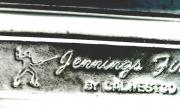I shot my first ever classifier today; I'd done pieces of it before but never the whole thing. I'd shot two IDPA matches prior to that. I am disappointed with a result. I had 44 points down, with a horrific 17 points down stage one. I did exactly what I tried not to do and a missed head shot. Twice.
With all of that, I made a sharpshooter.
Here is the question. I know I can clean up the head shots. I shot with an appendix holster which was positioned as far forward as rules allowed, but of course it screwed up my draw times; I can correct that. I am not closely familiar with IDPA target in that it is not very intuitive to me where the 8 ring is (from anatomic standpoint, its location is retarded and should be 2-3 inches higher); this can be corrected with experience. I got two procedurals for cover on stage 3, perhaps I can fix that. So, just right there, there are some seconds to shave. Say, 10 seconds on head misses and procedurals, maybe several more if I didn't fumble the draw, one reload was so-so.
So I am thinking, I'll clean all of that, and I'll make....a sharpshooter again.
My raw time was 115 seconds, which means that to make an expert, I need to shoot at the same speed and give up just 8 points, not 44. Doesn't sound realistic, does it?
So, the question # 1: it seems like to make a higher rating, I'd need a qualitative skill improvement, not just cleaning up the obvious stuff above?
#2: where the hell does one get a qualitative improvement? I am about 12K/year shooter, plus at least the same dry-fire volume, I cut down my 3-4 annual classes to zero for 2012 just to allocate time and resources to practice. I probably can shoot more volume-wise, and perhaps just a bit more dry-fire, but I have too many interests in life to increase my training exponentially.
This whole post, of course, is not about "how to help YVK to make an IDPA expert". It is about the #2 above, how do you find a way to make a next step when you have already been doing this for a few years, how do you - believably - fight off a thought that you're at the max of your potential no matter what or do you need to fight off that thought - maybe you should stop wasting time and money on chasing what you can't get? The man's nature is not to give up, and even non-incremental improvements are gratifying if they are in fact improvements and not random occurrences. As such, I'll enjoy shaving off seconds or minutes from whatever it is that I do, but realistic hope that the next big step is possible would be a nice motivator.
P.S. A practical question, don't know if it is answerable, but I'll ask anyway: given the data (115 sec raw, 44 points down): in practice and preparation, slow down to get better hits, speed up trying to maintain at list the same number of misses, or what? The question is driven by the fact that the overall winner of the match had 71 points down yet beat me by 17 seconds...




 Reply With Quote
Reply With Quote
 ], but overall, classifier doesn't seem to have a ton of it and is relatively fair assessment tool. You can substitute this with RSS course, or any short format stuff like FAST or DOTW. I had fun doing it, but, being a retentive dude that I am, I couldn't help but ask "how do I know I can do much better?"
], but overall, classifier doesn't seem to have a ton of it and is relatively fair assessment tool. You can substitute this with RSS course, or any short format stuff like FAST or DOTW. I had fun doing it, but, being a retentive dude that I am, I couldn't help but ask "how do I know I can do much better?"




